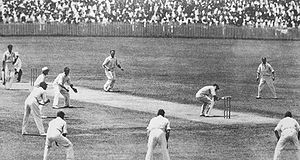 Image via Wikipedia Image via Wikipedia |
| An Australian cricket team in happier days: Perth 2006. |
Last Ashes series in Australia, to distract from their teams miserable performance, I read that the Barmy Army took to chanting the following chant:
“We’re fat, we’re round, three dollars to the pound!”
What’s that? The exchange rate? English fans are singing about the performance of their currency in relation to Australia’s? Yes, that was the case - you gotta love those barmy poms!
So, as a distraction of my own: “English food vs. Australian food” or more specifically “Tropical Fruit vs. Deciduous Fruit”. I must warn my readers, however, that I’m no botanist and I am going to using the terms “Tropical” and “Deciduous” shall we say “loosely”. And, if I happen to claim some mediterranean fruits as “tropical” forgive me, in penance I shan’t include the really unbeatable foods like coffee and chocolate because they don’t grow in Australia.
| Australian Mangoes |
Next, Strawberries. We get strawberries down here in Australia. Great big juicy Queensland strawberries, some as big as apples, and they taste like... they taste like... well, to be honest, they don’t really taste of anything, I don’t know what the big fuss is with strawberries? Or at least I didn’t until my first ever visit to the Northern Hemisphere, Québec, England, Finland, France, all delivered strawberries that were unbelievably sweet and full of flavour. In Australia, strawberries are generally eaten dipped in sugar and a punnet occasionally rots in the fridge uneaten. In England, a punnet might be finished on the same day it was bought, especially if it was bought from the local farmer’s market.
 Image via Wikipedia Image via Wikipedia |
| French Gariguette strawberries |
Grapefruit. It’s a bit sour, being a member of the citrus family, but if you follow these directions you can’t go wrong. 1) Cut the grapefruit in half. 2) Cut out the white “pith” from the centre. 3) Cut out the flesh of the fruit into “pizza” segments, but be careful not to cut through the skin. 4) Sprinkle 1 teaspoon of sugar over both halves. 5) Repeat step 4 - it is a member of the citrus family remember. 6) Dump another teaspoon of sugar right in the centre from where you removed the pith. 7) With a teaspoon, eat each of the segments you cut. 8) Now here comes the best part, close your eyes and picture yourself stranded on a tropical island where you haven’t had anything to drink for days, lift the grapefruit half to your lips as if it were a cup, now pour the delicious sugary fruit juice into your mouth, being sure to let some of it miss and run down your cheeks and neck in true Robinson Crusoe style!
Now, you can’t do that in England can you?
Ok ok, next fruit. Deciduous this time. Um, how about apples? Nice, but a bit boring. Then plums? Yeah, they’re delicious, but frankly the more sun the better and Australia has more than England. How about peaches? Ditto what I said about plums. Well, we’ll have to choose a tropical then: chillies! Fiery and exciting, forceful and with a take-no-prisoners attitude, definitely not a fruit for the faint-hearted. Sure you can grown them in England as well as in Australia, but whose temperament do they really suit better?
Well, if you’ve been following the Ashes series this summer, you’d have to say: “England”.







































